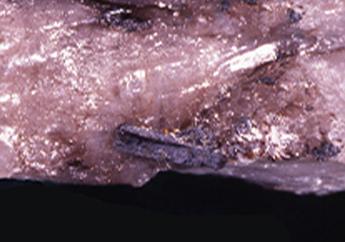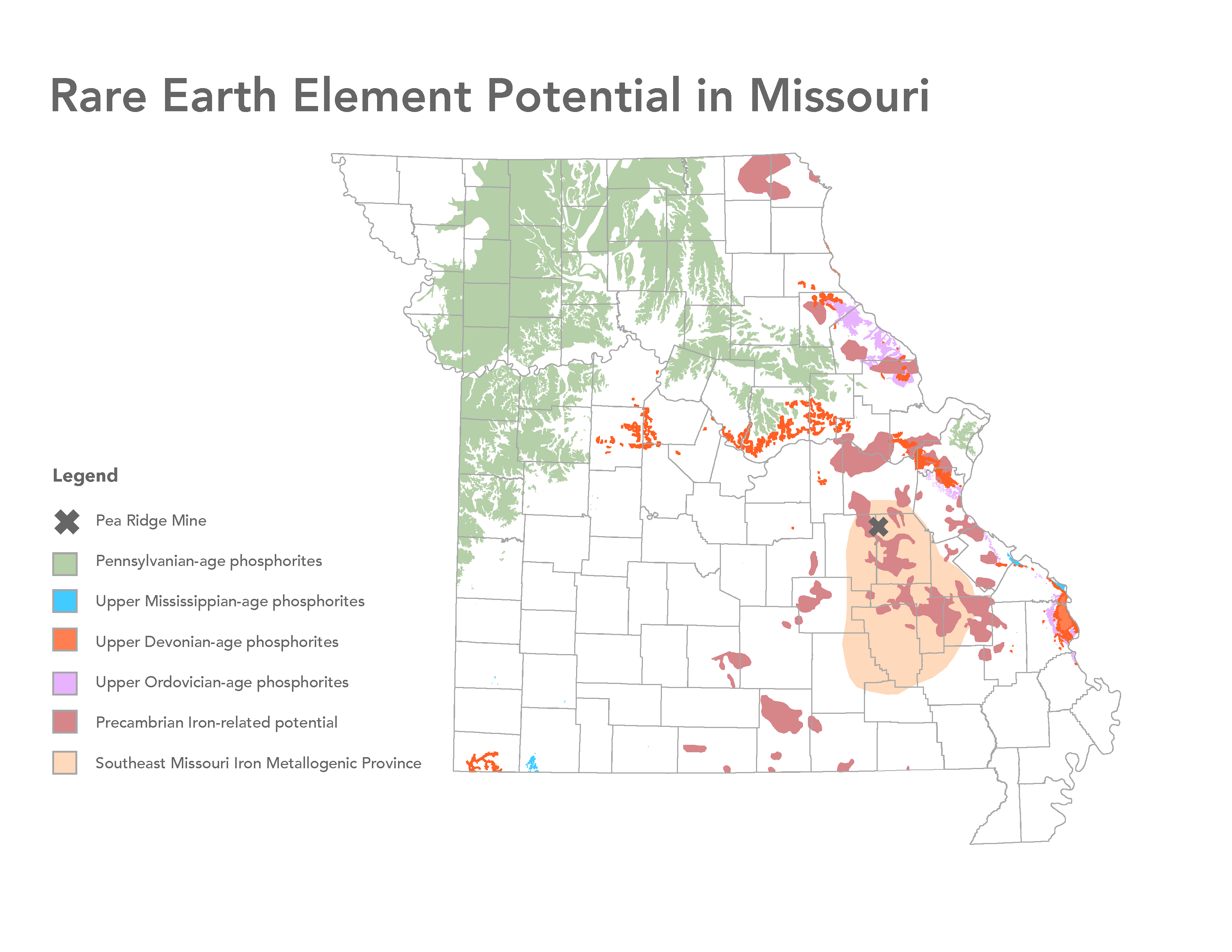Missouri Geological Survey Director: Carey Bridges, RG
Commodity
Rare earth elements, or REEs, are neither “rare” nor “earths.” REEs are metal elements that are relatively common in the Earth’s crust. The label “earths” was used as they were originally discovered as oxide compounds. They were described as “rare” as the minerals in which they are found are not often concentrated in geologic deposits.
The first identification of REEs was in 1792 by Finnish chemist Johan Gadolin, who examined a new mineral found in a quarry near the town of Ytterby, Sweden. Identifying a previously unrecognized component in the mineral and not realizing it was a mix of elements with similar properties, he named the entire group of elements as the new “element” ytterbia. The first individual REE to be identified was cerium in 1803. Identification of the remaining individual REEs continued until 1907 when the last naturally occurring REE, lutetium, was confirmed. The original name “ytterbia” is reflected in the names of four REEs – terbium, erbium, ytterbium and yttrium.
REEs are classified by the Secretary of the Interior’s 2018 Executive Order 13817 (Federal Register, 2018) as critical to the U.S. economy and to national security due to their many uses in defense- and energy-related applications. Since the United States relies on other countries for all production and processing of these elements, the U.S. Geological Survey (USGS) considers the U.S. to be 100% net import reliant on REEs.

The REEs include the lanthanide elements. These elements, followed by their chemical symbol and in their atomic order, are: lanthanum (La), cerium (Ce), praseodymium (Pr), neodymium (Nd), samarium (Sm), europium (Eu), gadolinium (Gd), terbium (Tb), dysprosium (Dy), holmium (Ho), erbium (Er), thulium (Tm), ytterbium (Yb), and lutetium (Lu). Yttrium (Y) is also considered a REE as it exhibits the same chemical properties as the lanthanides and is often found associated. Scandium (Sc) is at times included as it has similar chemical properties but is not generally found associated with the lanthanides.
Rare earth elements are divided into two groups, “light” and “heavy.” The “light” rare earths (LREE) are lanthanum, cerium, praseodymium, neodymium and samarium. The other nine lanthanides and yttrium comprise the “heavy” rare earths (HREE). Differences in the two groups are related to their chemical behavior which consequently affects their use. The HREEs are required for multiple critical defense and energy applications and are less abundant than the LREEs.
In Missouri, REEs are found in the REE ore minerals monazite, xenotime, bastnaesite, britholite, allanite, tengerite and synchisite. They may also be found in small amounts in the mineral apatite.
Economic Importance
While Missouri does not currently produce REEs, it is one of only 10 states in the U.S. known to have potentially economically viable REE deposits. The elements have the potential to be a factor in Missouri's future economic outlook. REEs are known to occur at the former Pea Ridge iron mine, located in Washington County. USGS describes the former mine as a principal REE deposit in the U.S., as it contains significant quantities of “heavy” REEs, especially yttrium. The possibility exists for REEs to be found in other iron deposits similar to Pea Ridge, or in phosphorite, a sedimentary rock found in the state.
Rare Earth Element Minerals Currently Known in Missouri
Most REE-bearing minerals currently known in Missouri are in two major mineral groups, phosphate minerals characterized by the chemical anion PO4 or carbonate minerals characterized by the anion CO3. An exception is the mineral britholite, a silicate mineral characterized by the presence of silica (Si) and lack of phosphate or carbonate anions (negatively charged ions). Minerals noted below have been identified in the REE mineralization at the Pea Ridge Mine; other REE-bearing minerals may be present but have not been identified. While the chemical formulas for these minerals list specific REEs, most REEs can substitute for one another in the chemical composition of the mineral. Because the REEs have similar chemical properties, multiple REEs are commonly found in the same geologic deposit.
Major REE-bearing Minerals in Missouri
- Monazite (Ce,La,Nd,Th)PO4
- Xenotime YPO4
Minor REE-bearing Minerals in Missouri
- Bastnaesite (Ce,La,Y,Nd)CO3(OH,F)
- Britholite (Ca,Ce,Y)5(SiO4,PO4)3(OH,F)
- Allanite [Ca(Ce,La,Y)](Al2Fe2+)O(OH)(SiO4)(Si2O7)
- Tengerite CaY3(CO3)4(OH)3·3H2O
- Synchisite Ca(Y,Ce)(CO3)2F
REEs also are often contained in the mineral apatite – Ca5(F,Cl,OH)(PO4)3 – where they substitute for other elements. REE-rich apatite is common in the Pea Ridge deposit. Apatite is also found in other iron deposits similar to Pea Ridge and may contain REEs as well.
Primary Uses
REEs are used every day in fluorescent and LED lights, computers, rechargeable batteries, flat screen displays, anti-lock brakes, microwaves, refrigerators and UV resistant glass. They are a major component of medical imaging equipment and green energy technologies such as hybrid and electric vehicles and wind turbines; a single wind turbine requires approximately 1,300 pounds of REEs. Defense technologies are a major user of REEs in applications that vary from simple night-vision goggles and laser-range finders to complex missile guidance systems, satellites and military jets.
Past Uses
REEs had only sporadic use for decades after their discovery. Lighter flints, metal alloys, polishing compounds for stone and gemstones, camping lantern mantles and tracer bullets were the most common uses until the mid-1960s, when color televisions were developed and required REEs to produce color. Oil refining and water treatment plants also became major users.
Production History
REEs have not been produced in Missouri. However, known reserves exist at the former Pea Ridge iron mine, and potential exists for REEs in other igneous-hosted iron deposits in southeast Missouri. In addition, unknown potential is present in phosphorous-rich sedimentary rocks found in Missouri.
Principal Locations of Rare Earth Elements in Missouri
Pea Ridge Iron Deposit, Washington County
- Precambrian rhyolite-hosted iron-oxide deposit with REEs and minor cobalt.
- The deposit was mined in the past for iron.
- REEs are found primarily in the minerals monazite, xenotime, and apatite; other minor REE-bearing minerals are present.
- Pea Ridge is notable for enrichments of yttrium and other HREEs.
- Potential REE reserves also exist in mine tailings from iron mining.
Other Possible Sources in Missouri
Southeast Missouri Iron Metallogenic Province
- The Province contains Pea Ridge and other igneous rock-hosted iron oxide deposits.
- Unknown REE potential in the other deposits. Deposits which were mined in the past may also have REE reserves in mine tailings.
- Other deposits also contain apatite, which may be a REE source.
Phosphorite deposits
- Phosphorites are found in multiple ages of geologic formations in Missouri.
- Phosphorites elsewhere are known to contain REE concentrations; their potential in Missouri is not currently evaluated.
Geologic Occurrence
Documented REE occurrences are associated with the iron oxide deposit (magnetite and hematite) at the former Pea Ridge iron mine. The deposit is Precambrian in age and is hosted in a volcanic igneous rock called rhyolite. The rhyolite and iron ores are covered by more than 1,000 feet of sedimentary rock. The iron oxide ores and REE-bearing minerals formed from igneous-derived fluids related to a 1.4 billion-year-old volcanic system. Iron-rich fluids released from an underlying magma chamber formed a large body of magnetite and hematite. REE-rich apatite formed at the same time as and is found with the iron ores. The major and minor REE-bearing minerals noted above are found in breccia pipes, pipe-shaped bodies of rock that were broken (brecciated) when a second release of fluids from the same magma chamber cut through the already emplaced iron oxide and rhyolite.
Rare earth elements also occur with phosphorites, a sedimentary rock with high concentrations of the element phosphorous. They are found in multiple counties in Missouri and are in Ordovician-, Devonian-, Mississippian- and Pennsylvanian-age rocks. Phosphorites formed when sea or ocean water became saturated with phosphorous. Changes in water temperature caused the phosphorous to precipitate out as phosphorous-rich minerals. REEs in the water also precipitated out in these minerals, creating REE-rich phosphorites.
Mining
Ores containing rare earth elements have not been mined in Missouri. Any future mining would follow processes similar to those of other mines. Ores would be blasted, crushed, transported to the surface, crushed further, and separated from other ores, non-ore minerals, and host rocks in a mill. Further processing would separate the different REEs from each other.
Resources
There are several resources available regarding REEs and other metallic minerals through the department’s Missouri Geological Survey. Scanned mine maps of Pea Ridge and other mines in the Missouri Mine Map Repository are accessible for viewing online. Hardcopies may be purchased by contacting our publications desk at 573-368-2100. Document and publication titles regarding rare earth elements can be browsed by accessing our Bibliography of Missouri Geology. Our McCracken Core Library and Research Center houses core from Pea Ridge and other iron oxide deposits such as Pilot Knob and Iron Mountain. Databases such as the Inventory of Mines, Occurrences and Prospects (IMOP) are available and can be downloaded as a KMZ file or an ESRI layer package through our GeoSTRAT tool. Historical files, commodity files, and mine maps not currently scanned are available for public viewing and inspection upon request. If you would like to visit our Rolla office regarding documents on metallic minerals in Missouri, please contact the Geological Survey Program at 573-368-2100.

References
Dicken, C.L., Horton, J.D., San Juan, C.A., Anderson, A.K., Ayuso, R.A., Bern, C.R., Bookstrom, A.A., Bradley, D.C., Bultman, M.W., Carter, M.W., Cossette, P.M., Day, W.C., Drenth, B.J., Emsbo, P., Foley, N.K., Frost, T.P., Gettings, M.E., Hammarstrom, J.M., Hayes, T.S., Hofstra, A.H., Hubbard, B.E., John, D.A., Jones, J.V.,III, Kreiner, D.C., Lund, K., McCafferty, A.E., Merchat, A.J., Ponce, D.A., Schulz, K.J., Shah, A.K., Siler, D.L., Taylor, R.D., Vikre, P.G., Walsh, G.J., Woodruff, L.G., and Zurcher, L., 2019, GIS and data tables for focus areas for potential domestic nonfuel sources of rare earth elements: U.S. Geological Survey data release, Continue to U.S. Department of the Interior website.
Federal Register, 2018, Department of the Interior Final List of Critical Minerals 2018; Federal Register, v. 83, no. 97, p. 23295-23296.
Other Critical Minerals in Missouri
Nothing in this document may be used to implement any enforcement action or levy any penalty unless promulgated by rule under chapter 536 or authorized by statute.
For more information
Geological Survey Program
Missouri Geological Survey
P.O. Box 250
Rolla, MO 65402-0250
United States
